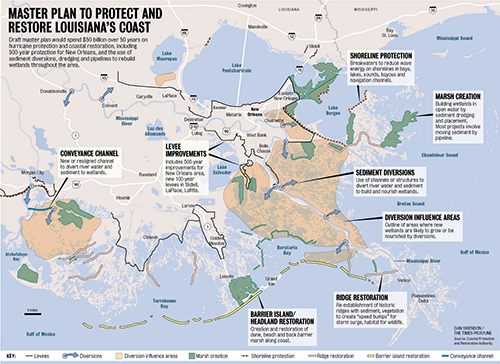Teams compete to design a sustainable Louisiana Coast
Bill Nuttle ·Three teams of coastal scientists, engineers, and planners are going head-to-head to see who can come up with the best ideas for creating a self-sustaining coast for Louisiana. That's the challenge posed by the Changing Course competition. Selection of these teams this summer completed a year-long process [pdf] that started with screening applications from over 21 groups. The eight strongest applicants were asked to prepare detailed proposals, which were reviewed last spring. (I participated in the selection process as a technical advisor to the competition.)
Building a more sustainable coast requires reengineering the Mississippi River to restore its natural land-building function. This function has been lost as a consequence of building levees and dikes along the river for flood control and to maintain a navigation channel. The last 80 years have seen increasing land loss throughout the deltaic region of the Mississippi, which is the centerpiece of the Louisiana coast. So much so that coastal Louisiana is known as "ground zero" for sea level rise in the US. People recognize that something must be done soon to prevent "the greatest environmental and economic disasters in [...] history" from coming to a catastrophic conclusion. A coastal restoration master plan developed by state authorities outlines a set of projects with an estimated total cost of $50 Billion, many of which would be the first of their kind.
Ground zero for sea level rise
It is difficult to imagine changing the Mississippi River, so important are the roles that it plays. The challenge set by the competition is this: how can we reengineer the river to restore its land-building function, without interrupting the other essential functions that the river delta provides? The main channel of the river south of New Orleans links the vast watershed of the Mississippi River to the Gulf of Mexico and world markets. The oil and gas facilities in the deltaic region provide a significant portion of the energy used in the US, and the region's wetlands support the largest fishery in the lower 48 states. Maintaining these functions is essential to the health of the US economy and world food supplies.
All three teams bring comparable expertise and ability to the competition. Competition organizers have been careful throughout the selection process to make sure that competitors understand the issues and grasp the scope and magnitude of what has to be done to achieve the objective of a self-sustaining coast. Organizers worked with each of the selected teams to assure that members balanced familiarity with the region with the ability to bring fresh perspectives to the challenges of restoring the Louisiana coast. While the competing teams are well-matched they differ significantly in how they approach the challenge put to them by the competition.

The Moffatt & Nichol Team combines the expertise of one of the premiere coastal engineering firms in the world with the resources of the LSU Coastal Sustainability Studio. Key members of this team were involved in developing the coastal master plan. At the same time, this team knows that now is the time for bold, provocative, out-of-the-box thinking.
The Studio MISI-ZIIBI Team is a multi-disciplinary design and planning team, partnered with top-grade national and international engineering expertise. Key members of this team helped redesigned parts of New Orleans devastated by Hurricane Katrina. They have a highly visual approach to problem solving.
The Baird Team assembles experts with experience solving challenging coastal planning problems outside of Louisiana but on a similar scale to here. The approach of this team is oriented to meeting the diverse needs of different stakeholder groups.
The results of the Changing Course competition are certain to be interesting no matter what they are. There is, of course, the suspense of what new ideas will come from the teams' creative efforts. More importantly, the competition will produce credible visions of what the Louisiana coast could look like 25 years, 50 years, or more in the future. Until now, coastal communities have been able only to watch as more and more of their history disappears under a rising sea. Visions of a sustainable coast that emerge from the Changing Course competition will provide a bridge for thinking about their future.

